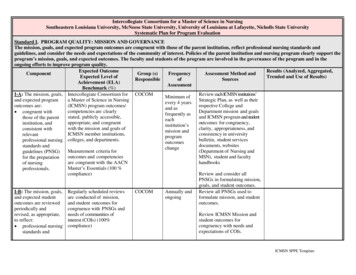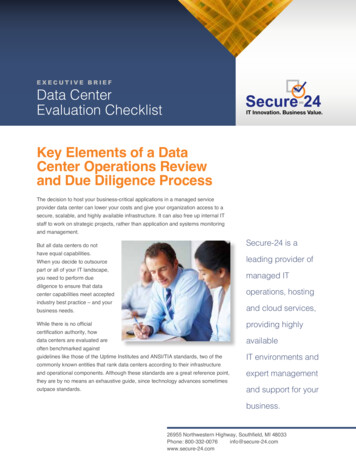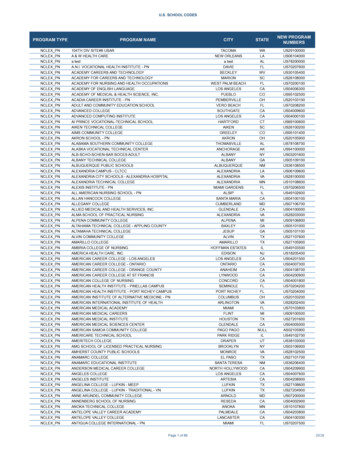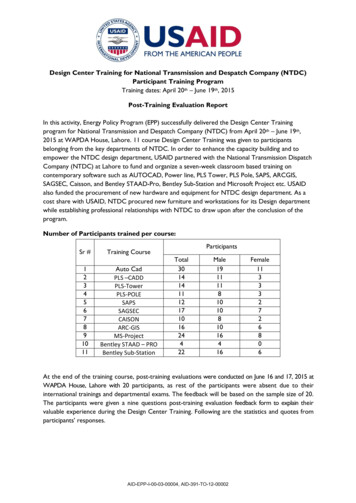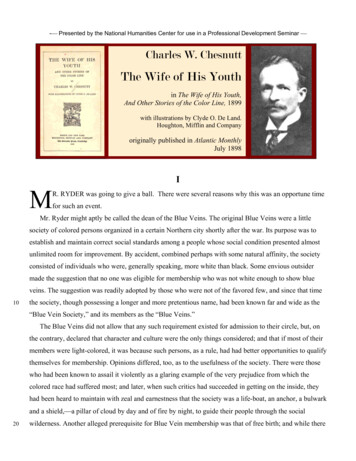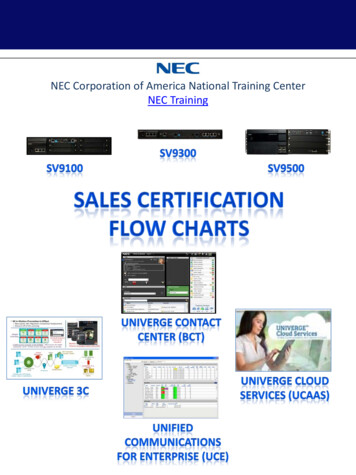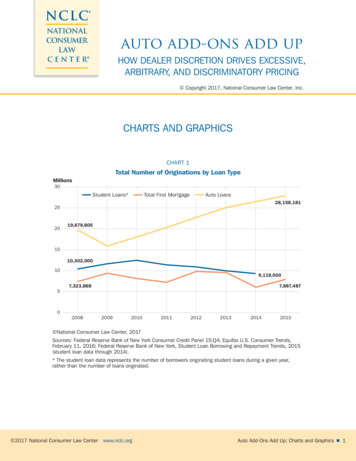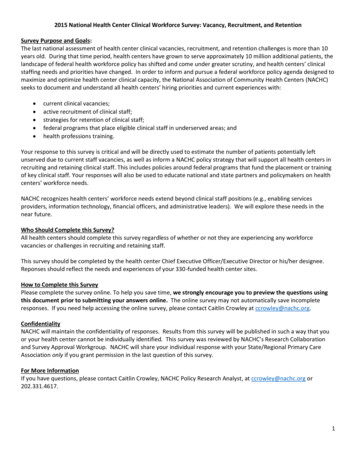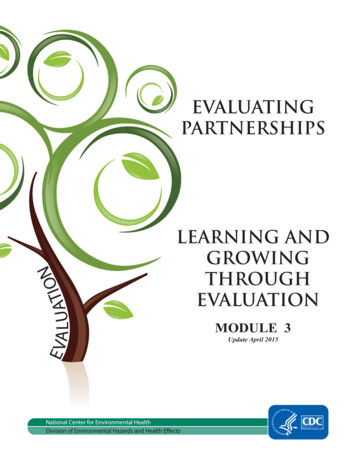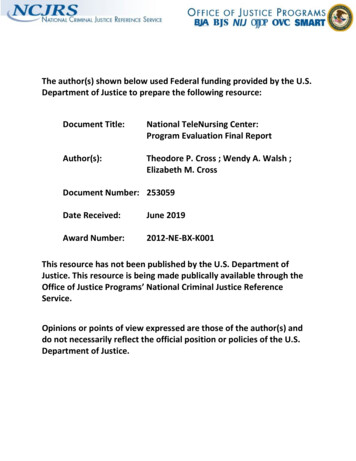
Transcription
The author(s) shown below used Federal funding provided by the U.S.Department of Justice to prepare the following resource:Document Title:National TeleNursing Center:Program Evaluation Final ReportAuthor(s):Theodore P. Cross ; Wendy A. Walsh ;Elizabeth M. CrossDocument Number: 253059Date Received:June 2019Award Number:2012-NE-BX-K001This resource has not been published by the U.S. Department ofJustice. This resource is being made publically available through theOffice of Justice Programs’ National Criminal Justice ReferenceService.Opinions or points of view expressed are those of the author(s) anddo not necessarily reflect the official position or policies of the U.S.Department of Justice.
National TeleNursing Center:Program Evaluation Final ReportOctober 2018Theodore P. CrossUniversity of Illinois at Urbana-CampaignWendy A. WalshUniversity of New HampshireElizabeth M. CrossCross Associates Research & Evaluation Services , LLCThis resource was prepared by the author(s) using Federal funds provided by the U.S.Department of Justice. Opinions or points of view expressed are those of the author(s) and do notnecessarily reflect the official position or policies of the U.S. Department of Justice.
Table of ContentsLIST OF TABLES AND FIGURES . VEXECUTIVE SUMMARY . VITHE DEVELOPMENT OF THE NATIONAL TELENURSING CENTER . VIOVERVIEW OF PREVIOUS EVALUATION REPORTS. VIIIDELIVERY OF TELENURSING SERVICES . XITHE TELENURSING EXPERIENCE . XILESSONS LEARNED AND REMAINING QUESTIONS . XIIEstablishment of sites .xiiDelivery of telenursing services . xiiiValue of telenursing encounters . xiiiTraining and system change efforts . xiiiSustainability of telemedicine for sexual assault patients . xiiiConclusion . xivCHAPTER 1: INTRODUCTION . 1THE NATIONAL TELENURSING CENTER .1PROGRAM EVALUATION APPROACH .2CHAPTER 2: THE DEVELOPMENT OF THE NATIONAL TELENURSING CENTER . 3CENTER DEVELOPMENT .4Project Management .4TeleNursing Center Space .4Technology .5Advocacy .6Marketing and Outreach .6WORKFORCE DEVELOPMENT .8Recruitment of TeleSANEs .8Professional Practice Model and Protocols .8Licensing and Credentialing .9Training of TeleSANEs .9SITE DEVELOPMENT .10Site Selection .10The Development of Site Teams .11Site Education and Training .12Variability in Site Development .12SUSTAINABILITY.13PROJECT TIMELINE.14CHAPTER 3: AN OVERVIEW OF PREVIOUS PROGRAM EVALUATION REPORTS . 16PROCESS AND DEVELOPMENT OF THE NATIONAL TELENURSING CENTER .16EVALUATION OF THE TRAINING AND EDUCATION ACTIVITIES OF THE NATIONAL SEXUAL ASSAULT TELENURSING CENTER. .172This resource was prepared by the author(s) using Federal funds provided by the U.S.Department of Justice. Opinions or points of view expressed are those of the author(s) and do notnecessarily reflect the official position or policies of the U.S. Department of Justice.
NATIONAL TELENURSING CENTER: INITIAL PROGRAM EVALUATION FINDINGS ON THE TELENURSING EXPERIENCE .18PROGRAM EVALUATION REPORT: THE SYSTEM IMPACT OF THE NATIONAL TELENURSING CENTER.18CHAPTER 4: DELIVERY OF TELENURSING SERVICES . 24TELENURSING SERVICE UTILIZATION .24Number of Telenursing Encounters .24Age and Gender of Sexual Assault Patients .28Length of Encounter .29Declining Telenursing .30Consultations.31SUMMARY .32CHAPTER 5: THE TELENURSING EXPERIENCE . 34EVALUATION METHODS .34POST-ENCOUNTER INTERVIEW RESULTS .36Patient consent .36Working together as a team .36Effectiveness of technology .37Assistance provided during encounter .38Monitoring, review, and leadership. . 38Evidence collection. . 39Documentation. . 40Examination procedures and management. . 40Direct patient support and education. . 41Patient medical care. 41History-taking. . 41Emotional support. 42Little assistance needed. . 42IMPACT OF TELENURSING SERVICES .43TeleSANEs’ experience providing support .43Initiating the telemedicine support. . 44Challenges to providing assistance. . 44What TeleSANEs might do differently next time. . 45Recommendations for future training of other teleSANEs and site clinicians. . 45Site clinician perspective: telenursing experience as a great resource. . 46Non-SANE sites. . 46SUMMARY .47CHAPTER 6: LESSONS LEARNED AND REMAINING QUESTIONS . 49ESTABLISHMENT OF SITES.49THE DELIVERY OF TELENURSING SERVICES .50THE VALUE OF TELENURSING ENCOUNTERS .50THE ROLE OF TRAINING AND SYSTEM CHANGE EFFORTS.52THE SUSTAINABILITY OF TELENURSING FOR SEXUAL ASSAULT PATIENTS .52CONCLUSION .55APPENDIX A: REFERENCES . 56APPENDIX B: NATIONAL TELENURSING CENTER LOGIC MODEL . 583This resource was prepared by the author(s) using Federal funds provided by the U.S.Department of Justice. Opinions or points of view expressed are those of the author(s) and do notnecessarily reflect the official position or policies of the U.S. Department of Justice.
APPENDIX C: NUMBER OF ENCOUNTERS PER SITE PER MONTH . 594This resource was prepared by the author(s) using Federal funds provided by the U.S.Department of Justice. Opinions or points of view expressed are those of the author(s) and do notnecessarily reflect the official position or policies of the U.S. Department of Justice.
List of Tables and FiguresTABLE 1. NATIONAL TELENURSING CENTER SITES . 1FIGURE 1. NTC CORE PROCESSES . 3TABLE 2. NTC PARTNERS . 4TABLE 3 NATIONAL TELENURSING CENTER SITES AND NUMBER OF CLINICIANS WHO HAVE RECEIVED NTC . 12FIGURE 2. NTC KEY START-UP AND IMPLEMENTATION MILESTONES . 15TABLE 4. SUMMARY OF NTC PROJECT EVALUATION REPORTS 2015 - 2018 . 21TABLE 5. NATIONAL TELENURSING CENTER SITES, LENGTH OF TIME OPEN AND NUMBER OF ENCOUNTERS . 25FIGURE 3. NUMBER OF TELENURSING ENCOUNTERS BY MONTH AND YEAR . 26FIGURE 4. CUMULATIVE TOTAL OF TELENURSING ENCOUNTERS BETWEEN MAY 2015 AND MARCH 2018 . 26FIGURE 5. PERCENTAGE OF ENCOUNTERS BY DAY OF WEEK . 27FIGURE 6. PERCENTAGE OF ENCOUNTERS BY MONTH OF YEAR . 27FIGURE 7. PERCENTAGE OF ENCOUNTERS BY TIME OF DAY . 28FIGURE 8. DISTRIBUTION OF AGE OF SEXUAL ASSAULT PATIENTS (N 56) . 29TABLE 6. LENGTH OF ENCOUNTERS BY SITE . 29TABLE 7. LENGTH OF POST ENCOUNTER (JUNE 2017- MARCH 2018), BY SITE. 30TABLE 8. REASON WHY ENCOUNTERS DID NOT OCCUR (N 84) . 31TABLE 9. NUMBER OF CONSULTATIONS BY SITE . 32TABLE 10. CONSULTATION ASSISTANCE (JUNE 2017-MARCH 2018, N 38) . 32TABLE 11. DISTRIBUTION OF INTERVIEWS BY SITE (TOTAL COMPLETED INTERVIEWS N 178) . 35FIGURE 9. TYPES OF ASSISTANCE REPORTED IN TELESANE, SITE CLINICIAN, AND CORPSMEN INTERVIEWS . 39TABLE 12. AVERAGE RATINGS OF IMPACT OF TELENURSING . 43FIGURE 10. AVERAGE RATINGS OF OVERALL QUALITY OF TELENURSING . 43FIGURE 11. NUMBER OF TELENURSING ENCOUNTERS ROBERT BUSH NAVAL HOSPITAL NOVEMBER 2014 THROUGH MARCH 2018 . 59FIGURE 12. NUMBER OF TELENURSING ENCOUNTERS SUTTER LAKESIDE HOSPITAL JUNE 2015 THROUGH MARCH 2018 . 59FIGURE 13. NUMBER OF TELENURSING ENCOUNTERS NAVAL HOSPITAL CAMP PENDLETON JANUARY 2016 THROUGH MARCH 2018 . 60FIGURE 14. NUMBER OF TELENURSING ENCOUNTERS METROWEST MEDICAL CENTER APRIL 2016 THROUGH MARCH 2018 . 60FIGURE 15. NUMBER OF TELENURSING ENCOUNTERS SAINT ANNE’S HOSPITAL JULY 2016 THROUGH MARCH 2018 . 61vThis resource was prepared by the author(s) using Federal funds provided by the U.S.Department of Justice. Opinions or points of view expressed are those of the author(s) and do notnecessarily reflect the official position or policies of the U.S. Department of Justice.
Executive SummaryThe National TeleNursing Center (NTC) was established through a multi-year grant from the U.S.Department of Justice, Office for Victims of Crime (OVC) awarded to the Massachusetts (MA)Department of Public Health’s Sexual Assault Nurse Examiner (SANE) program. The grant supports thedevelopment, implementation and evaluation of a telemedicine project to provide expert consultationto nurses conducting forensic sexual assault medical examinations in remote and/or underservedhospitals. The project was designed to address unmet need in four patient populations consideredunderserved: rural, military, Native American, and correctional. The initial four sites included two navalhospitals, a rural hospital, and a tribal hospital. The project later added two hospitals serving an urbanand suburban population respectively. After initial attempts early in the project, the NTC
the project came from the Director of the Massachusetts SANE Program and an Associate Director, who have been the co-directors of the NTC Project. The administrative staff of the Center has also included an NTC Associate Director/Director, an NTC Educator, an Operations and Strategic Pla

